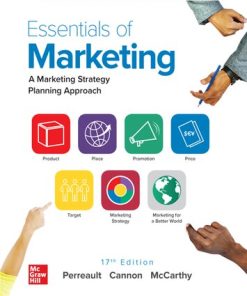Essentials of Marketing Analytics 1st Edition by Joseph Hair 1264263651 9781264263653
$50.00 Original price was: $50.00.$25.00Current price is: $25.00.
Essentials of Marketing Analytics 1st Edition by Joseph F. Hair – Ebook PDF Instant Download/DeliveryISBN: 1264263651 9781264263653
Full download Essentials of Marketing Analytics 1st Edition after payment.

Product details:
ISBN-10 : 1264263651
ISBN-13 : 9781264263653
Author : Joseph F. Hair
The starting point in learning marketing analytics is to understand the marketing problem. The second is asking the right business question. The data will help you tell the story. We live in a global, highly competitive, rapidly changing world that is increasingly influenced by digital data, expanded analytical capabilities, information technology, social media and more. The era of Big Data has literally brought about huge amounts of data to review, analyze and solve. Today’s undergraduate and graduate students will need to have a keen understanding of not only the right types of questions to ask, but also the tools available to help answer them. Essentials of Marketing Analytics covers both in a comprehensive, readable and flexible manner. Coverage includes the most popular analytics software tools, such as Tableau and Python, as well as a variety of analytical techniques, including but not limited to social network analysis, automated machine learning, neural networking and more.
Essentials of Marketing Analytics 1st Table of contents:
Chapter 1: Introduction to Marketing Analytics
Part 1: Overview of Marketing Analytics and Data Management
Chapter 1 Introduction
1.1 Introduction to Marketing Analytics
Marketing Analytics Defined
Analytics Levels and Their Impact on Competitive Advantage
1.2 Defining the Right Business Problems
1.3 Data Sources
1.4 Data Types
Types of Data
Data Measurement
Metric Measurement Scales
1.5 Predictors versus Target Variable
Types of Variables
1.6 Modeling Types: Supervised Learning versus Unsupervised Learning
1.7 The 7-Step Marketing Analytics Process
Step 1: Business Problem Understanding
Step 2: Data Understanding and Collection
Step 3: Data Preparation and Feature Selection
Step 4: Modeling Development
Step 5: Model Evaluation and Interpretation
Step 6: Model and Results Communication
Step 7: Model Deployment
1.8 Ethical Considerations
1.9 Setting Yourself Apart
Summary of Learning Objectives and Key Terms
Learning Objectives
Key Terms
Discussion and Review Questions
Critical Thinking and Marketing Applications
References
Chapter 2: Data Management
Chapter 2 Introduction
2.1 The Era of Big Data Is Here
2.2 Database Management Systems (DBMS)
2.3 Enterprise Data Architecture
Traditional ETL
ETL Using Hadoop
A Closer Look at Data Storage
2.4 Data Quality
2.5 Data Understanding, Preparation, and Transformation
Data Understanding
Data Preparation
Data Transformation
Case Study: Avocado Toast: A Recipe to Learn SQL
Getting Started
Understanding the Dataset
Applying the Concepts
Aggregation
Build Your Own Supplier Table
Add Data to Your Table
Join the Two Tables (MERGE)
Update the Data
Delete Values
Data Is the Currency of Marketing
Summary of Learning Objectives and Key Terms
Learning Objectives
Key Terms
Discussion and Review Questions
Critical Thinking and Marketing Applications
References
Chapter 3: Exploratory Data Analysis Using Cognitive Analytics
Part 2: Exploring and Visualizing Data Patterns
Chapter 3 Introduction
3.1 The Importance of Exploratory Data Analysis
3.2 Defining Cognitive Analytics and Knowledge Discovery
The Cognitive Analytics Technology that Won Jeopardy
3.3 Discovering Different Use Cases for Cognitive Analytics
Cognitive Analytics to Interface with the Customer
Cognitive Analytics to Support Internal Operations and Decision Making
3.4 Combining Internal and External Data Sources for Improved Insights
Case Study: A Closer Look at Online Customer Experience
Understanding the Business Problem
Understanding the Dataset
Applying the Concepts
Insights Learned from Applying Visualization Concepts
Summary of Learning Objectives and Key Terms
Learning Objectives
Key Terms
Discussion and Review Questions
Critical Thinking and Marketing Applications
References
Chapter 4: Data Visualization
Chapter 4 Introduction
4.1 What Is Data Visualization?
4.2 Principles and Elements of Design for Data Visualization
Principles of Design
The Basic Elements of Design
4.3 Fundamental Considerations When Developing Data Visualizations
Common Types of Charts and Graphs
4.4 So, What’s Your Story?
Case Study: Telecommunications: Optimizing Customer Acquisition
Understanding the Business Problem
Understanding the Dataset
Data Preparation
Applying the Concepts
Insights Learned from Applying the Concepts
Summary of Learning Objectives and Key Terms
Learning Objectives
Key Terms
Discussion and Review Questions
Critical Thinking and Marketing Applications
References
Chapter 5: Regression Analysis
Part 3: Analytical Methods for Supervised Learning
Chapter 5: Introduction
5.1 What Is Regression Modeling?
Simple Linear Regression
Multiple Linear Regression
Evaluating the Ability of the Regression Model to Predict
5.2 The Predictive Regression Model
5.3 Predictive Regression Performance
5.4 Model Validation
5.5 Modeling Categorical Variables
5.6 Model Independent Variable Selection
Feature Selection
Case Study: Need a Ride? Predicting Prices that Customers Are Willing to Pay for Ridesharing Services
Understanding the Business Problem
Understanding the Dataset
Data Preparation
Applying the Concepts
Step 1: Preparing the Data for Modeling
Step 2: Setting Up the Training Model and Cross Validation
Step 3: Evaluating the Model Results
Step 4: Applying the Model to New Dataset
Insights Learned from Applying the Concepts
Summary of Learning Objectives and Key Terms
Learning Objectives
Key Terms
Discussion and Review Questions
Critical Thinking and Marketing Applications
References
Chapter 6: Neural Networks
Chapter 6 Introduction
6.1 Introduction to Neural Networks
6.2 How Are Neural Networks Used in Practice?
6.3 What Are the Basic Elements of a Neural Network?
6.4 How Does a Neural Network Learn?
What Does This Process Look Like in Action?
How Does the Network Learn?
When Does the Network Stop Learning?
6.5 Key Reminders When Using Neural Networks
Case Study: Airline Industry: Understanding Customer Satisfaction
Understanding the Business Problem
Understanding the Dataset
Preparing the Data
Applying the Concepts
Stage 1: Preparing the Data for Modeling
Stage 2: Setting Up the Training Model and Cross Validation
Stage 3: Evaluating the Model Results
Stage 4: Applying the Model to a New Dataset
Insights Learned from Applying the Concepts
Summary of Learning Objectives and Key Terms
Learning Objectives
Key Terms
Discussion and Review Questions
Critical Thinking and Marketing Applications
References
Chapter 7: Automated Machine Learning
Chapter 7 Introduction
7.1 What Is Automated Machine Learning (AutoML)?
What Questions Might Arise?
7.2 AutoML in Marketing
Which Companies Are Actively Using AutoML?
7.3 What Are Key Steps in the Automated Machine Learning Process?
Data Preparation
Model Building
Creating Ensemble Models
Advanced Ensemble Methods
Model Recommendation
Case Study: Loan Data: Understanding When and How to Support Fiscal Responsibility in Customers
Understanding the Business Problem
Understanding the Dataset
Uploading the Data
Examining the Features
Defining the Target Variable
Running the Model
Evaluating the Model Results
Applying the Model to Predict New Cases
Insights Learned from Applying the Concepts
Summary of Learning Objectives and Key Terms
Learning Objectives
Key Terms
Discussion and Review Questions
Critical Thinking and Marketing Applications
References
Chapter 8: Cluster Analysis
Part 4: Analytical Methods for Unsupervised Learning
Chapter 8 Introduction
8.1 What Is Cluster Analysis?
8.2 How Is Cluster Analysis Used in Practice?
8.3 How Does a Cluster Analysis Function?
8.4 What Are the Types of Cluster Analysis?
K-Means Clustering
K-Means Issues to Remember
Hierarchical Clustering
Hierarchical Clustering Issues to Remember
Case Study: Online Perfume and Cosmetic Sales: Understanding Customer Segmentation through Cluster Analysis
Understanding the Business Problem
Understanding the Dataset
Applying the Concepts
Stage 1: Preparing the Data for Modeling
Stage 2: Applying Cluster Analysis and Evaluating the Outcomes
Insights Learned from Applying the Concepts
Are You Ready for a Challenge?
Summary of Learning Objectives and Key Terms
Learning Objectives
Key Terms
Discussion and Review Questions
Critical Thinking and Marketing Applications
References
Chapter 9: Market Basket Analysis
Chapter 9 Introduction
9.1 What Is Market Basket Analysis?
9.2 How Is Market Basket Analysis Used in Practice?
9.3 Association Rules: How Does a Market Basket Analysis Identify Product Relationships?
9.4 Special Topics in Market Basket Analysis
Case Study: Online Department Store: Understanding Customer Purchase Patterns
Understanding the Business Problem
Understanding the Dataset
Data Preparation
Applying the Concepts
Loading Data
Preparing the Data
Running FP-Growth
Creating Association Rules
Insights Learned from Applying the Concepts
Summary of Learning Objectives and Key Terms
Learning Objectives
Key Terms
Discussion and Review Questions
Critical Thinking and Marketing Applications
References
Chapter 10: Natural Language Processing
Part 5: Emerging Analytical Approaches
Chapter 10 Introduction
10.1 What Is Natural Language Processing?
10.2 How Is Natural Language Processing Used in Practice?
Optimize Inventory and Engage Customers in Marketing Campaigns
Develop New Products to Meet Customer Needs
Simplify Guest Travel to Improve Hospitality
Create a Better Experience for Customers
Add Unique Features to Products
Improve Customer Service
Facilitate Customer Ordering
Strengthen Customer Relationships
10.3 How Is Text Analytics Applied?
Step 1: Text Acquisition and Aggregation
Step 2: Text Preprocessing
Tokenization
Stemming
Lemmatization
Stop Words Removal
N-Grams
Bag of Words
Term-Document Matrix
Step 3: Text Exploration
Frequency Bar Chart
Word Clouds
Step 4: Text Modeling
10.4 Special Topics in Text Analytics
Case Study: Specialty Food Online Review: Understanding Customer Sentiments
Understanding the Business Problem
Understanding the Dataset
Data Preparation
Applying the Concepts
Stage 1: Preparing the Data for Text Analysis
Stage 2: Topic Modeling and Sentiment Analysis
Are You Ready for a Challenge?
Insights Learned from Applying the Concepts
Summary of Learning Objectives and Key Terms
Learning Objectives
Key Terms
Discussion and Review Questions
Critical Thinking and Marketing Applications
References
Chapter 11: Social Network Analysis
Chapter 11 Introduction
11.1 What Is Social Network Analysis?
11.2 Social Network Analysis in Practice
11.3 How Does a Social Network Analysis Function?
Network Measures
Measures of Centrality
Network Structures
11.4 Link Prediction Using Social Network Analysis
Case Study: Auto Industry: Understanding Network Influencers
Understanding the Business Problem
Understanding the Dataset
Data Preparation
Applying the Concepts
Step 1: Getting Started with Polinode
Step 2: Uploading Data to Polinode
Step 3: Viewing the Network Graph
Step 4: Measuring Network Properties
Step 5: Updating Nodes Graph View
Step 6: Running a Network Report and Downloading Results
Insights Learned from Applying the Concepts
Summary of Learning Objectives and Key Terms
Learning Objectives
Key Terms
Discussion and Review Questions
Critical Thinking and Marketing Applications
References
Chapter 12: Fundamentals of Digital Marketing Analytics
Chapter 12 Introduction
12.1 What Are the Basics of Digital Marketing?
What Is Owned Digital Media?
What Is Paid Digital Media?
What Is Earned Digital Media?
How Is Digital Marketing Used?
12.2 Digital Marketing Analytics in Practice
Owned Digital Marketing Media
Paid Digital Marketing Media
Earned Digital Marketing Media
12.3 Digital Marketing Analytics Measures
Audience Analysis
Acquisition Analysis
Behavior Analysis
Conversion Analysis
A/B Testing
Multivariate Testing
Multichannel Attribution
12.4 How Does A/B Testing Work?
Case Study: E-Commerce: The Google Online Merchandise Store
Understanding the Business Problem
Understanding the Dataset
Applying the Concepts
Getting Started with Google Analytics
Step 1: Accessing the Demo Account
Step 2: Reviewing the Reports
Insights Learned from Applying the Concepts
A Final Note
Summary of Learning Objectives and Key Terms
Learning Objectives
Key Terms
Discussion and Review Questions
Critical Thinking and Marketing Applications
References
Glossary
Glossary
People also search for Essentials of Marketing Analytics 1st:
essentials of marketing analytics 1st edition
essentials of marketing analytics 1st edition pdf
essentials of marketing analytics. mcgraw-hill
essentials of marketing analytics 2024 release
essentials of marketing analytics test bank
Tags:
Essentials,Marketing Analytics,Joseph Hair,marketing problem,business question
You may also like…
Business & Economics - Sales & Marketing
Essentials of Marketing Research 5th Edition Joseph F. Hair Jr.
Business & Economics - Sales & Marketing
Uncategorized
Business & Economics - Sales & Marketing
Business & Economics - Sales & Marketing
Business & Economics - Sales & Marketing
Essentials of Services Marketing 4th Edition Jochen Christopher Patricia 1292425164 9781292425160












